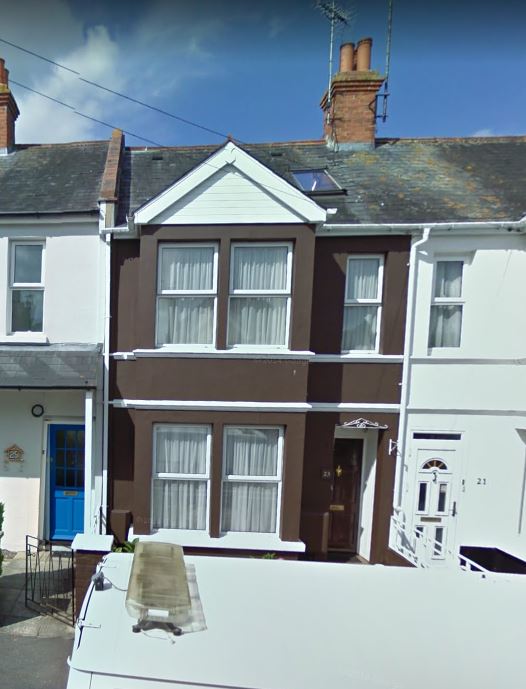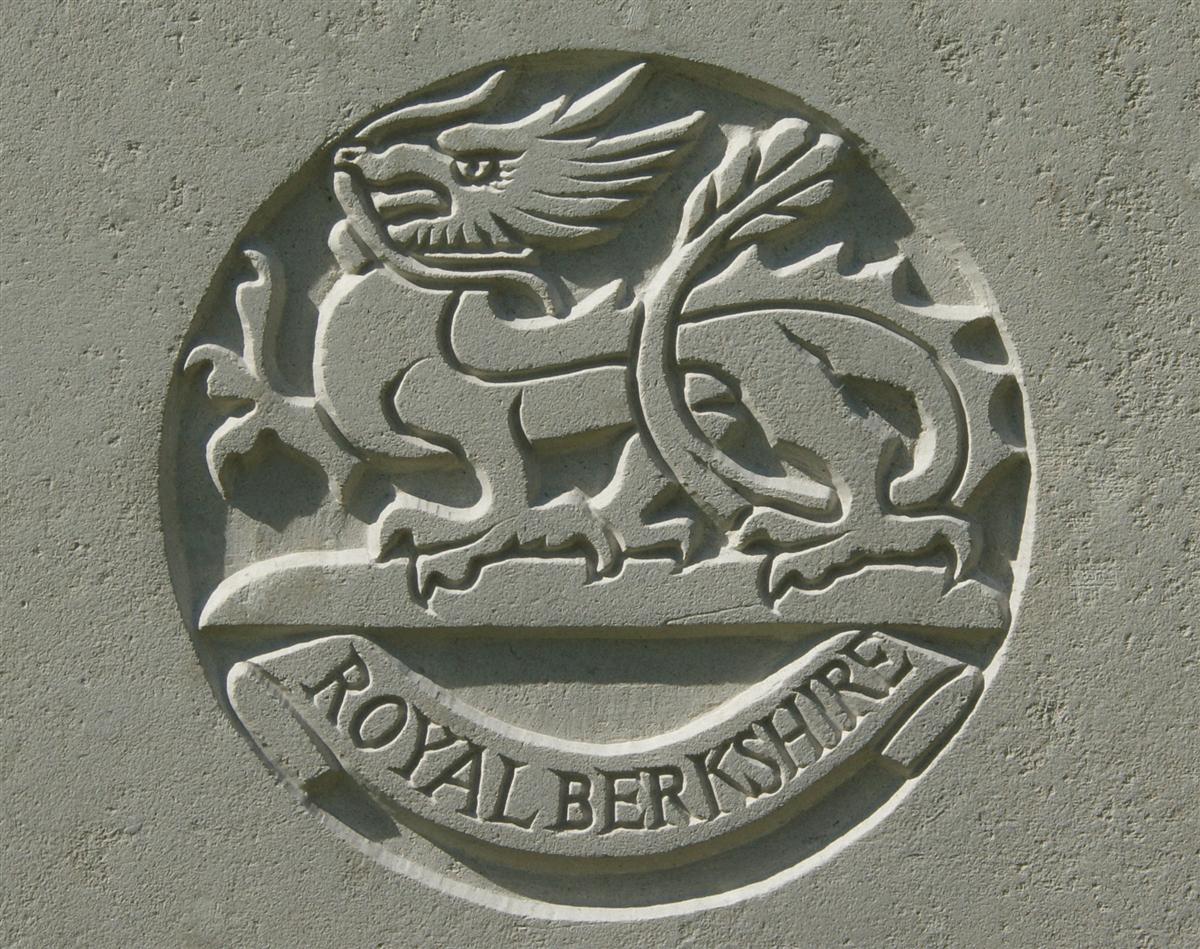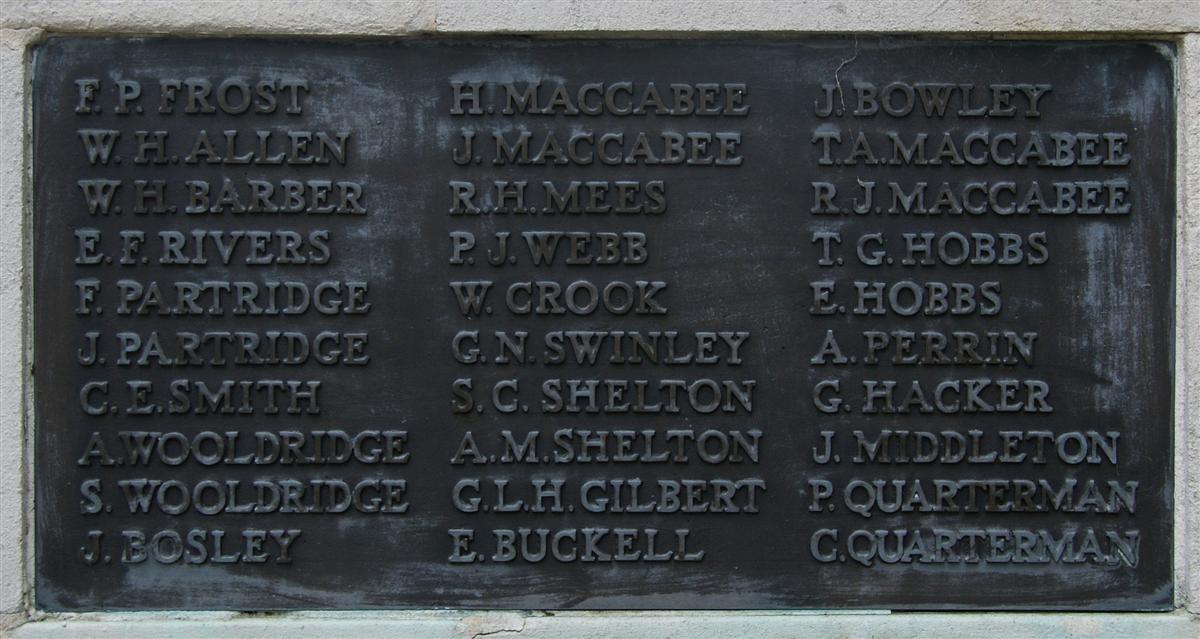Ernest Francis Rivers
Private 23951 Ernest Francis Rivers, 2nd Battalion, Royal Berkshire Regiment

23 Salcombe Road - 'Byron' when the Rivers family lived here in 1911. |
William was a shoe and boot repairer working from home and at least one of his children (Arthur) followed him into the trade. In 1906 Walter lied about his age to enlist into the local militia (3rd Battalion, Royal Berkshire Regiment), but he purchased his release in 1908 after only two years of the six-year term he had signed up for. This coincides with the time that the Territorial Army was formed to bring the local militias into a closer alignment with the regular forces.
When war broke out in 1914 it was not long before the Rivers boys decided to get involved; William and Arthur joined the Royal Berkshire Regiment together on 29 December 1914, presumably with the aim of serving together – but the Army had other ideas and they were posted to different battalions (William to the 6th Battalion and Arthur to the 8th).
By this time Francis Ernest was evidently using Ernest rather than Francis and it was as Ernest Francis that he followed his elder brothers’ examples by enlisting into the Royal Berkshire Regiment. It appears that he donned the khaki uniform in March 1916 – which suggests that he had volunteered under the Derby Scheme in late 1915 and was then called up in March following his eighteenth birthday. This would be in line with the family legend that has him following his brothers William’s example in 1915.

The regimental badge of the Royal Berkshire Regiment, as used on CWGC headstones. |
This was a very confused time, the detailed diary was probably lost and this minimal entry added after the event. As the German forces overran a considerably amount of territory many units were cut off and forced to surrender or die – leading to a high number of men being taken prisoner.
Ernest was one of the missing, initially it would not be known if he was alive or dead, wounded or fit, captured or lost in the confusion – just that he was not with the battalion. As the offensive petered out and order began to prevail in the British lines many stragglers found their way back to their battalions, but not Ernest.
His parents did not have to wait long for news, though it was the news they would have dreaded:
Newbury Weekly News 25 April 1918 – Local War Notes
Mrs Rivers, of Denmark Road, received the sad news on Saturday that her youngest son, Pte Ernest Francis Rivers, was killed in action between March 22nd and April 2nd. Ernest was only 20, and formerly belonged to St Nicholas Church Lads’ Brigade. He is Mrs Rivers’ fifth son; three others have served in France, though only Albert, Royal Garrison Artillery, remains, William and Arthur having returned home wounded.
Quite bizarrely the Reading Mercury of 14 September 1918 carried the news that two men previously reported as ‘missing’ were now reported as having died while prisoners in enemy hands. The two were both from Newbury, George Hacker and Ernest.
It is far from clear how a man reported dead in April would be reported as dying in captivity so long after. It is possible that this gave rise to the family legend that he starved to death in a POW camp. Red Cross records give rise to an alternative explanation. These consist of two small entries, under two different names (C F Rivers and L Rivers) that list pay books and ID tags that were sent to the German Zentralstelle fur Nachlassachen (Central Office for Estate Affairs) on or before 30 May 1918. Although the initials are incorrect they both identify the soldier as No 23951, Royal Berks – Ernest. These records state that the owner of these items was not definitely deceased, but the destination of the items suggests that death was being presumed. Pay books and ID tags were commonly removed from corpses prior to burial in order to provide a record of the death, it seems like that this was the case in this instance. The pay books were forwarded from a field hospital (sanitats kompagnie), where he may well have died from wounds received in action in late April or a subsequent infection. It seems very unlikely that he was starved to death.
However, Ernest’s story does not end with his death. His records held by the Commonwealth War Graves Commission reveal that he was buried at least three times.
He was buried by the Germans at map reference 62b.T.14.d.9.8, which relates to a park in the centre of St Quentin. This location adds further support to the theory that he died in a German medical facility as St Quentin was well behind enemy lines at this time. In November 1919 his remains were moved to St Martin’s Military Cemetery Extension (grave 1.A.9) a short distance east of St Quentin; no doubt the townsfolk preferred a park to a makeshift cemetery! Then, in December 1923, he was moved again, to his current resting place in grave 1.G.33 at St Souplet British Cemetery, 33km north east of St Quentin.
 Ernest's name on Newbury War Memorial. (upper left) |
Locally his name is remembered on panel 2 of the Newbury Town War Memorial and on the memorial board and roll of honour in St Nicolas’ Church. He was also remembered on the memorial board in St John’s Church, which was lost when the church was destroyed by an enemy bomb in 1943.
Family
As noted in Ernest’s short obituary, three of his five brothers (William, Albert and Arthur) served on the Western Front; the sixth and youngest brother, Edward, was too young. It is not known if Walter served in any capacity (many soldiers served on the Home Front and did not qualify for the medals that make those who served overseas a little easier to trace) – he could, of course, have been unfit or working in what would be known as a ‘reserved occupation’ in World War Two. However, he did have some military service; he enlisted in the local militia (3rd Battalion, Royal Berkshire Regiment) on 30 August 1906 when he was seventeen. He did not serve for long, buying himself out on 23 April 1908. When he enlisted he was working for Eastman’s Ltd as a butcher, presumably at their shop at 29 Cheap Street. This occupation was unlikely to protect him from conscription, but it may well have meant that he served in the UK, providing butchery skills to the immense effort required to supply well over a million men in the field.
William served with the 6th Battalion, Royal Berkshire Regiment (Private 16217), crossing the Channel on 11 August 1915, two weeks after the battalion crossed as a unit. He was not in France/Flanders for long, on 18 May 1916 he was discharged as no longer fit for service owing to ‘sickness’. Discharge would not take place instantly, he may well have succumbed to the hardships of life in the trenches over the winter of 1915/16. However, it was not a life-threatening condition, he lived a full life. According to his grand-daughter he had a lifelong regret that his young brother, Ernest, followed his example in enlisting, blaming himself for Ernest’s death.
Arthur served in the 8th Battalion, Royal Berkshire Regiment (Private 16220). The 8th Battalion crossed to France on 7 August 1915, without Arthur, who crossed exactly a month later, on 7 September. It seems quite odd that both brothers would have this short delay before joining their battalion in France, Arthur’s case giving rise to the thought that the date was recorded incorrectly.
On 25 September the newly arrived battalion was involved in the largest British offensive to date, the Battle of Loos. This was also the first time the British used gas, which was released from canisters in the expectation that it would drift across enemy lines blown by the slight breeze present. Sadly, the wind changed, and the gas inflicted most of its casualties on the British and Empire soldiers poised to attack – including Arthur. Ironically, he may have been among the 300 men from the battalion who helped position the gas cylinders a few days before the attack. His name was included in a list of casualties in the Reading Mercury of 2 October 1915 – remarkably soon after the event.
Gassing could kill or inflict sever and permanent damage, but most cases saw a complete recovery in a matter of days or weeks. Arthur was treated at a hospital in Harfleur and was soon passed fit; he returned to the battalion on 5 October. He wrote to his mother from hospital:
Reading Mercury, 31 September 1915
Pte. Arthur Rivers, writing to his mother, Mrs Rivers of Denmark Road, Newbury. During the great advance he was overcome by poisonous gas and his great regret was that he was unable to keep up with his chums.
He did not spend long with his chums, on 18 November 1915 he was admitted into a Casualty Clearing Station (field hospital) suffering from neurasthenia or shell shock. He did not recover so readily this time and was transferred to a hospital in England on 5 December 1915. Eventually he was transferred to the Class W reserve on 20 December 1916 and to Class P on 10 January 1917. This latter date was recorded on his 1914-15 Medal Roll entry as his date of discharge, this is not the case – though it may well have been seen by his regiment as such. Class W and P Reserves were soldiers who were deemed to be more valuable to the country in civil rather than military employment. The men remained in the Army Reserve and could be ordered to report for duty at a moment’s notice but did not undertake any military duties or wear a uniform and did not receive any army pay. How much Arthur’s shell shock (post traumatic stress disorder as it would be termed today) influenced the value judgement can only be guessed at. On 23 January 1918 he was finally discharged from the P Reserve as being no longer fit for service owing to neurasthenia. It is not known whether his condition affected his later life, but he lived to a good age

